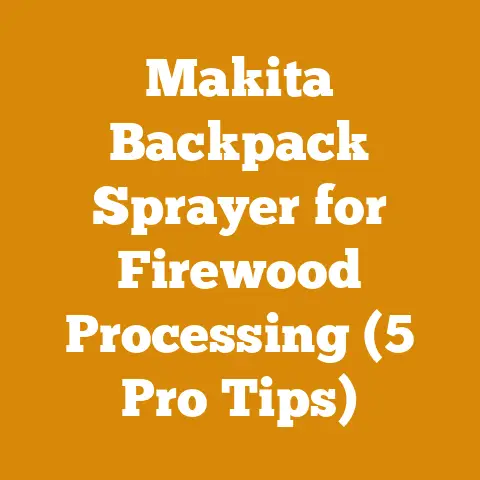Husqvarna 44 Chainsaw Repair Tips (5 Pro Woodcutting Hacks)
Alright, let’s dive into the world of Husqvarna 44 chainsaws and woodcutting, shall we? I’ve spent years in the woods, and I can tell you there’s nothing quite like the feeling of a well-maintained chainsaw slicing through a seasoned log.
Expert Tip: Always sharpen your chain before you start cutting. A sharp chain not only makes the job easier but also significantly reduces the risk of kickback, a common cause of chainsaw injuries. Think of it like this: a dull chain forces the saw to “beat” the wood, increasing vibration and the chance of the saw bouncing back at you. A sharp chain, on the other hand, “bites” into the wood, providing a smooth and controlled cut.
- Mastering Chainsaw Maintenance: Learn to diagnose and fix common Husqvarna 44 chainsaw issues to extend its lifespan and performance.
- Optimizing Cutting Techniques: Discover five professional woodcutting hacks to improve efficiency, safety, and reduce waste.
- Fuel Efficiency & Performance: Understand how fuel mixtures, chain lubrication, and air filter maintenance impact your chainsaw’s power and fuel consumption.
- Safety First: Reinforce essential safety practices to prevent accidents and injuries while operating a chainsaw.
- Troubleshooting Like a Pro: Equip yourself with the knowledge to identify and resolve performance problems, from starting issues to chain binding.
Introduction: My Husqvarna 44 Story
My journey with chainsaws began years ago, fueled by a need to heat my home with wood during harsh winters. The Husqvarna 44 quickly became my go-to workhorse. I remember one particularly brutal winter where I had to fell and process over 10 cords of wood. The 44, with its reliable engine and sturdy build, was indispensable. But like any machine, it required consistent care and occasional repairs. Through trial and error (and a few close calls), I learned the ins and outs of keeping it running smoothly.
This article is born from that experience. I’ll share not only repair tips specific to the Husqvarna 44 but also five professional woodcutting hacks that have saved me time, energy, and a few headaches over the years. It’s about making your woodcutting efficient, safe, and, dare I say, even enjoyable.
Understanding the Husqvarna 44: A Legacy of Reliability
The Husqvarna 44, while not the newest model on the market, enjoys a reputation for its robust design and straightforward mechanics. It’s a classic for a reason. Its simplicity means it’s relatively easy to repair and maintain, even for those with limited mechanical experience. However, understanding its key components is essential for effective troubleshooting.
Key Components of the Husqvarna 44
- Engine: A two-stroke engine requiring a specific fuel-oil mixture. This is the heart of the chainsaw.
- Carburetor: Regulates the air-fuel mixture entering the engine.
- Ignition System: Provides the spark to ignite the fuel mixture.
- Fuel System: Includes the fuel tank, fuel lines, and fuel filter.
- Oil System: Lubricates the chain and bar.
- Chain and Bar: The cutting components.
- Clutch: Connects the engine to the chain.
- Air Filter: Prevents debris from entering the engine.
Common Husqvarna 44 Problems and Repair Tips
Let’s get down to brass tacks. Here are some common issues you might encounter with your Husqvarna 44 and how to tackle them:
1. Chainsaw Won’t Start
This is the most frequent complaint I hear. Here’s a systematic approach to diagnosing the problem:
- Fuel:
- Check the fuel level: Obvious, but easily overlooked.
- Freshness: Old fuel can degrade and cause starting problems. I recommend using fuel that is less than 30 days old, especially if it contains ethanol. Ethanol attracts moisture, which can lead to corrosion and poor engine performance. In fact, a study by the Outdoor Power Equipment Institute (OPEI) found that over 70% of small engine failures are related to fuel issues.
- Fuel Mixture: Ensure the correct fuel-oil ratio (typically 50:1). Too much oil can foul the spark plug, while too little can cause engine damage.
- Fuel Filter: A clogged fuel filter restricts fuel flow. Replace it annually or more frequently if you notice debris in the fuel tank.
- Spark:
- Spark Plug: Remove the spark plug and inspect it. A fouled spark plug will be black and oily. Clean it with a wire brush or replace it.
- Spark Test: With the spark plug removed and connected to the spark plug wire, hold the plug against the engine block and pull the starter cord. You should see a strong spark. If not, the ignition coil may be faulty.
- Air:
- Air Filter: A dirty air filter restricts airflow, leading to a rich fuel mixture and starting problems. Clean the air filter regularly with soap and water or compressed air.
- Compression:
- Compression Test: This requires a compression tester. A healthy engine should have a compression reading of at least 100 PSI. Low compression indicates worn piston rings or a damaged cylinder.
Personal Story: I once spent an entire afternoon wrestling with a Husqvarna 44 that wouldn’t start. I checked the fuel, the spark, and the air filter, all to no avail. Finally, in desperation, I decided to check the spark plug gap. It was way off! Adjusting the gap to the correct specification (usually around 0.020 inches) instantly solved the problem. This taught me the importance of paying attention to even the smallest details.
2. Chainsaw Starts but Stalls
If your Husqvarna 44 starts but stalls shortly after, the issue is likely related to fuel delivery or carburetor settings.
- Carburetor Adjustment: The carburetor controls the air-fuel mixture. It has two main adjustment screws: the low-speed (L) screw and the high-speed (H) screw.
- Low-Speed (L) Screw: Adjusts the fuel mixture at idle and low speeds. Turning it clockwise leans the mixture (less fuel), while turning it counterclockwise richens the mixture (more fuel).
- High-Speed (H) Screw: Adjusts the fuel mixture at high speeds. Similar to the low-speed screw, clockwise leans the mixture, and counterclockwise richens it.
- Adjustment Procedure:
- Start the chainsaw and let it warm up.
- Turn the low-speed (L) screw until the engine idles smoothly without stalling.
- Adjust the high-speed (H) screw while the engine is at full throttle. The goal is to find the setting that provides the most power without the engine sounding strained or sputtering.
- Make small adjustments (1/8 turn) and allow the engine to stabilize before making further changes.
- Fuel Line Issues:
- Cracked or Leaking Fuel Lines: Inspect the fuel lines for cracks or leaks. Replace them if necessary.
- Clogged Fuel Lines: Disconnect the fuel lines and blow them out with compressed air.
- Impulse Line: The impulse line connects the carburetor to the crankcase and provides pressure pulses that help draw fuel into the carburetor. A cracked or leaking impulse line can cause stalling problems.
3. Chainsaw Chain Not Oiling
Proper chain lubrication is crucial for preventing premature wear and damage to the chain and bar. If the chain isn’t oiling properly, here’s what to check:
- Oil Level: Ensure the oil reservoir is full.
- Oil Type: Use a high-quality bar and chain oil. Avoid using motor oil or other substitutes, as they may not provide adequate lubrication.
- Oil Filter: A clogged oil filter restricts oil flow. Clean or replace it as needed.
- Oil Pump: The oil pump is responsible for delivering oil to the chain. If the pump is faulty, it may need to be replaced.
- Bar Oil Hole: The oil hole on the bar can become clogged with debris. Clean it with a small wire or a bar groove cleaner.
Data Point: Studies have shown that proper chain lubrication can extend the life of the chain and bar by up to 50%. Insufficient lubrication leads to increased friction, heat, and wear, which can quickly damage the cutting components.
4. Chainsaw Chain Binds or Jams
A chain that binds or jams can be frustrating and dangerous. Here’s what to look for:
- Chain Tension: Ensure the chain is properly tensioned. A loose chain can derail and bind, while an overtight chain can cause excessive wear.
- Bar Condition: A damaged or worn bar can cause the chain to bind. Check the bar for burrs, grooves, or other damage. Use a bar rail dresser to smooth out any imperfections.
- Chain Sharpness: A dull chain requires more force to cut, increasing the risk of binding. Sharpen the chain regularly.
- Cutting Technique: Improper cutting techniques, such as pinching the bar in the cut, can cause the chain to bind. Use wedges to keep the cut open and prevent pinching.
5. Excessive Vibration
Excessive vibration can indicate a serious problem with the chainsaw. Ignoring it can lead to further damage and potential injury.
- Loose Components: Check for loose screws, bolts, and other components. Tighten them as needed.
- Damaged Anti-Vibration Mounts: The Husqvarna 44 has anti-vibration mounts that isolate the engine from the handles. If these mounts are damaged, they will not effectively dampen vibration. Replace them if necessary.
- Bent Crankshaft: A bent crankshaft can cause severe vibration. This is a major repair that may require professional assistance.
- Chain Condition: A damaged or improperly sharpened chain can cause excessive vibration. Inspect the chain for damage and sharpen it properly.
5 Pro Woodcutting Hacks for Efficiency and Safety
Now, let’s move beyond repairs and into the realm of optimizing your woodcutting techniques. These five hacks have significantly improved my efficiency and safety over the years.
1. The Hinge Cut: Mastering Directional Felling
Directional felling is crucial for controlling where a tree falls. The hinge cut is the heart of this technique. It allows you to guide the tree’s descent with precision.
- The Process:
- Plan Your Escape Route: Before making any cuts, clear a path for yourself at a 45-degree angle away from the anticipated fall direction.
- The Notch Cut: Make a notch cut on the side of the tree facing the direction you want it to fall. The notch should be about one-fifth of the tree’s diameter. The top cut of the notch should be angled down at about 45 degrees, and the bottom cut should be horizontal.
- The Hinge Cut: Make a horizontal cut on the opposite side of the tree, slightly above the bottom of the notch. Leave a hinge of wood (about 10% of the tree’s diameter) between the horizontal cut and the notch. This hinge will control the tree’s fall.
- Driving Wedges: If the tree doesn’t start to fall on its own, drive wedges into the horizontal cut behind the hinge to help push the tree over.
- Why It Works: The hinge acts as a guide, ensuring the tree falls in the intended direction. Wedges provide additional leverage and prevent the saw from being pinched.
Expert Quote: “Directional felling is not just about getting the tree on the ground; it’s about controlling the entire process to minimize risk and maximize efficiency,” says Arne Johansen, a seasoned logger from Norway. “The hinge cut is the key to achieving that control.”
2. The Bore Cut: Avoiding Pinching
The bore cut is a technique used to avoid pinching the saw when cutting through thick logs. It involves plunging the saw into the log before making the final cut.
- The Process:
- Make an Initial Cut: Make a small notch on the top of the log where you want to make the cut.
- Plunge Cut: With the saw running at full throttle, carefully plunge the tip of the bar into the log at a slight angle. Use the bumper spikes to stabilize the saw.
- Pivot and Cut: Once the bar is fully inserted, pivot the saw to cut through the log from the inside out.
- Final Cut: Finish the cut by sawing through the remaining wood on the outside of the log.
- Why It Works: By cutting from the inside out, you create a space for the wood to expand, preventing the bar from being pinched.
3. The Reactive Force Grip: Maximizing Control
The reactive force grip is a technique for holding the chainsaw that maximizes control and reduces fatigue. It involves wrapping your thumbs around the handles and maintaining a firm grip.
- The Process:
- Thumb Placement: Wrap your thumbs around the handles, rather than placing them alongside your fingers.
- Firm Grip: Maintain a firm grip on the handles, but avoid squeezing too tightly.
- Body Positioning: Position your body so that you are balanced and stable. Keep your feet shoulder-width apart and bend your knees slightly.
- Why It Works: Wrapping your thumbs around the handles provides a more secure grip and allows you to better control the saw. Proper body positioning helps to maintain balance and reduce fatigue.
Personal Story: I used to suffer from arm fatigue after long days of cutting wood. I tried various techniques, but nothing seemed to help until I learned the reactive force grip. By wrapping my thumbs around the handles, I was able to maintain a more secure grip and reduce the amount of force I needed to exert. This simple change made a huge difference in my stamina and reduced my risk of injury.
4. The Felling Lever: Easing the Fall
A felling lever is a tool used to help push trees over and prevent them from falling in the wrong direction. It provides leverage and control, making felling safer and easier.
- The Process:
- Make the Hinge Cut: Prepare the tree with a proper hinge cut as described above.
- Insert the Felling Lever: Insert the felling lever into the horizontal cut behind the hinge.
- Apply Pressure: Use the lever to apply pressure in the direction you want the tree to fall.
- Monitor the Tree: Watch the tree carefully and be prepared to move if it starts to fall unexpectedly.
- Why It Works: The felling lever provides leverage and control, making it easier to push the tree over in the desired direction.
5. The Limb Lock: Secure Limb Removal
The limb lock is a technique for removing limbs from a felled tree safely and efficiently. It involves using the weight of the limb to your advantage.
- The Process:
- Identify Tension: Determine which side of the limb is under tension. This is the side that will spring back when cut.
- Relieve Tension: Make a shallow cut on the tension side of the limb.
- Final Cut: Make the final cut on the opposite side of the limb.
- Why It Works: By relieving the tension before making the final cut, you prevent the limb from springing back and potentially injuring you.
Maintaining Peak Performance: Fuel, Lubrication, and Air
Beyond repairs and cutting techniques, maintaining peak performance hinges on three key elements: fuel, lubrication, and air.
Fuel: The Lifeblood of Your Chainsaw
- Fuel Mixture: The Husqvarna 44 requires a specific fuel-oil mixture, typically 50:1. Use a high-quality two-stroke oil that is specifically designed for chainsaws.
- Ethanol Concerns: Ethanol-blended fuels can cause problems with small engines. Ethanol attracts moisture, which can lead to corrosion and poor engine performance. If possible, use ethanol-free fuel. If you must use ethanol-blended fuel, add a fuel stabilizer to prevent it from degrading.
- Fuel Storage: Store fuel in a clean, airtight container. Keep the container in a cool, dry place away from direct sunlight.
Data Point: A study by the American Society of Agricultural and Biological Engineers (ASABE) found that using ethanol-blended fuel in small engines can reduce fuel efficiency by up to 10% and increase emissions.
Lubrication: Keeping Things Running Smoothly
- Bar and Chain Oil: Use a high-quality bar and chain oil to lubricate the chain and bar. Avoid using motor oil or other substitutes, as they may not provide adequate lubrication.
- Oil Level: Check the oil level regularly and refill as needed.
- Oil Filter: Clean or replace the oil filter as needed to ensure proper oil flow.
Air: Breathing Easy
- Air Filter Maintenance: A clean air filter is essential for proper engine performance. Clean the air filter regularly with soap and water or compressed air. Replace the air filter annually or more frequently if you operate in dusty conditions.
Safety First: Essential Practices for Chainsaw Operation
No amount of skill or experience can compensate for neglecting safety. Chainsaw operation is inherently dangerous, and it’s crucial to follow these essential safety practices:
- Personal Protective Equipment (PPE):
- Helmet: Protects your head from falling debris.
- Eye Protection: Protects your eyes from flying chips and debris.
- Hearing Protection: Protects your ears from the loud noise of the chainsaw.
- Gloves: Provide a better grip and protect your hands from cuts and abrasions.
- Chaps: Protect your legs from chainsaw cuts.
- Steel-Toed Boots: Protect your feet from falling logs and chainsaw cuts.
- Read the Manual: Familiarize yourself with the chainsaw’s operating instructions and safety precautions.
- Inspect the Chainsaw: Before each use, inspect the chainsaw for any damage or loose parts.
- Clear the Work Area: Remove any obstacles from the work area and ensure you have a clear escape route.
- Start the Chainsaw Safely: Start the chainsaw on the ground, with your foot firmly planted on the rear handle.
- Use Proper Cutting Techniques: Use the correct cutting techniques for the task at hand.
- Be Aware of Kickback: Kickback is a sudden and forceful backward movement of the chainsaw that can cause serious injury. Be aware of the risk of kickback and take steps to prevent it.
- Never Cut Above Shoulder Height: Cutting above shoulder height is dangerous and increases the risk of losing control of the chainsaw.
- Take Breaks: Chainsaw operation can be physically demanding. Take frequent breaks to avoid fatigue.
- Never Operate a Chainsaw Under the Influence: Operating a chainsaw under the influence of alcohol or drugs is extremely dangerous and illegal.
Expert Quote: “Chainsaws are powerful tools, but they are also unforgiving,” says Sarah Miller, a certified arborist. “Safety should always be your top priority. Never compromise on safety, no matter how experienced you are.”
Troubleshooting Like a Pro: Beyond the Basics
Sometimes, the problem isn’t as straightforward as a clogged fuel filter or a dull chain. Here are some more advanced troubleshooting tips:
1. Diagnosing Carburetor Issues
If you’ve adjusted the carburetor and the engine still isn’t running properly, there may be a more serious problem with the carburetor.
- Carburetor Cleaning: Disassemble the carburetor and clean it thoroughly with carburetor cleaner. Pay close attention to the jets and passages.
- Carburetor Rebuild: If cleaning doesn’t solve the problem, you may need to rebuild the carburetor with a rebuild kit. This involves replacing the gaskets, diaphragms, and other worn parts.
- Carburetor Replacement: In some cases, the carburetor may be beyond repair and need to be replaced.
2. Inspecting the Ignition System
If you’re not getting a spark, the problem may be with the ignition system.
- Ignition Coil: The ignition coil is responsible for generating the high-voltage spark that ignites the fuel mixture. Test the ignition coil with a multimeter to see if it is producing the correct voltage.
- Flywheel: The flywheel contains magnets that generate the electrical current for the ignition system. Inspect the flywheel for damage and ensure that the magnets are strong.
- Wiring: Check the wiring for any damage or loose connections.
3. Checking Compression
Low compression can indicate serious engine damage.
- Compression Tester: Use a compression tester to measure the compression in the cylinder. A healthy engine should have a compression reading of at least 100 PSI.
- Possible Causes: Low compression can be caused by worn piston rings, a damaged cylinder, or a leaky valve.
Conclusion: Mastering Your Husqvarna 44 and Woodcutting Skills
The Husqvarna 44 is a reliable and capable chainsaw that can provide years of service with proper care and maintenance. By understanding its key components, learning how to diagnose and repair common problems, and mastering essential woodcutting techniques, you can maximize its performance and efficiency.
Remember, safety should always be your top priority. Wear appropriate personal protective equipment, follow safe operating procedures, and never compromise on safety.
Now, go forth and conquer those logs! And remember, a sharp chain, a well-maintained saw, and a healthy dose of caution are your best friends in the woods.
Actionable Next Steps:
- Sharpen Your Chain: Invest in a good quality chainsaw file and learn how to sharpen your chain properly.
- Inspect Your Saw: Before each use, inspect your Husqvarna 44 for any damage or loose parts.
- Practice Safe Cutting Techniques: Master the hinge cut, bore cut, and other essential woodcutting techniques.
- Maintain Your Saw Regularly: Clean the air filter, check the oil level, and lubricate the chain regularly.
- Invest in PPE: Ensure you have all the necessary personal protective equipment, including a helmet, eye protection, hearing protection, gloves, chaps, and steel-toed boots.
Happy cutting!






